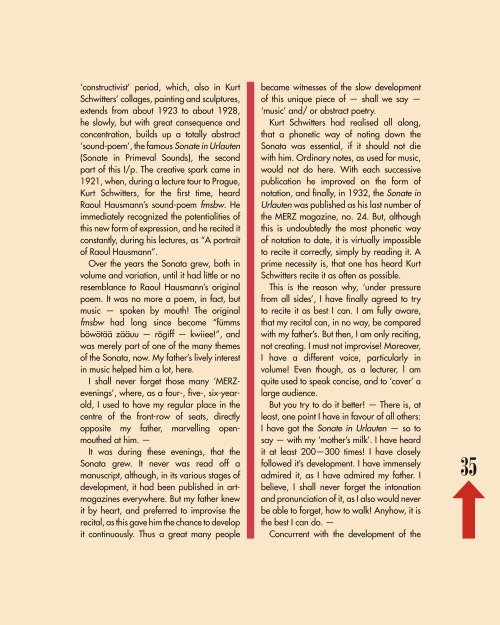Kurt Schwitters: Merz (2016) – Norman Rosenthal interviews Damien Hirst
Fully illustrated catalog published by Galerie Gmurzynska in collaboration with Cabaret Voltaire Zurich on the occasion of Kurt Schwitters: MERZ, a major retrospective exhibition celebrating 100 years of Dada. The exhibition builds and expands on the gallery’s five decade long exhibition history with the artist, featuring exhibition architecture by Zaha Hadid. Edited by Krystyna Gmurzynska and Mathias Rastorfer. First of three planned volumes containing original writings by Kurt Schwitters, historical essays by Ernst Schwitters, Ad Reinhardt and Werner Schmalenbach as well as text contributions by Siegfried Gohr, Adrian Notz, Jonathan Fineberg, Karin Orchard, and Flavin Judd. Foreword by Krystyna Gmurzynska and Mathias Rastorfer. Interview with Damien Hirst conducted by Norman Rosenthal. Includes full color plates and archival photographs. 174 pages, color and b/w illustrations. English. ISBN: 978-3-905792-33-1 The publication includes an Interview with Damien Hirst by Sir Norman Rosenthal about the importance of Kurt Schwitters's practice for Hirst's work.
Fully illustrated catalog published by Galerie Gmurzynska in collaboration with Cabaret Voltaire Zurich on the occasion of Kurt Schwitters: MERZ, a major retrospective exhibition celebrating 100 years of Dada. The exhibition builds and expands on the gallery’s five decade long exhibition history with the artist, featuring exhibition architecture by Zaha Hadid.
Edited by Krystyna Gmurzynska and Mathias Rastorfer.
First of three planned volumes containing original writings by Kurt Schwitters, historical essays by Ernst Schwitters, Ad Reinhardt and Werner Schmalenbach as well as text contributions by Siegfried Gohr, Adrian Notz, Jonathan Fineberg, Karin Orchard, and Flavin Judd.
Foreword by Krystyna Gmurzynska and Mathias Rastorfer.
Interview with Damien Hirst conducted by Norman Rosenthal.
Includes full color plates and archival photographs.
174 pages, color and b/w illustrations.
English.
ISBN:
978-3-905792-33-1
The publication includes an Interview with Damien Hirst by Sir Norman Rosenthal about the importance of Kurt Schwitters's practice for Hirst's work.
Create successful ePaper yourself
Turn your PDF publications into a flip-book with our unique Google optimized e-Paper software.
‘constructivist’ period, which, also in <strong>Kurt</strong><br />
<strong>Schwitters</strong>’ collages, painting and sculptures,<br />
extends from about 1923 to about 1928,<br />
he slowly, but with great consequence and<br />
concentration, builds up a totally abstract<br />
‘sound-poem’, the famous Sonate in Urlauten<br />
(Sonate in Primeval Sounds), the second<br />
part of this I/p. The creative spark came in<br />
1921, when, during a lecture tour to Prague,<br />
<strong>Kurt</strong> <strong>Schwitters</strong>, for the first time, heard<br />
Raoul Hausmann’s sound-poem fmsbw. He<br />
immediately recognized the potentialities of<br />
this new form of expression, and he recited it<br />
constantly, during his lectures, as “A portrait<br />
of Raoul Hausmann”.<br />
Over the years the Sonata grew, both in<br />
volume and variation, until it had little or no<br />
resemblance to Raoul Hausmann’s original<br />
poem. It was no more a poem, in fact, but<br />
music — spoken by mouth! The original<br />
fmsbw had long since become “fümms<br />
böwötää zääuu — rögiff — kwiiee!”, and<br />
was merely part of one of the many themes<br />
of the Sonata, now. My father’s lively interest<br />
in music helped him a lot, here.<br />
I shall never forget those many ‘MERZevenings’,<br />
where, as a four-, five-, six-yearold,<br />
I used to have my regular place in the<br />
centre of the front-row of seats, directly<br />
opposite my father, marvelling openmouthed<br />
at him. —<br />
It was during these evenings, that the<br />
Sonata grew. It never was read off a<br />
manuscript, although, in its various stages of<br />
development, it had been published in artmagazines<br />
everywhere. But my father knew<br />
it by heart, and preferred to improvise the<br />
recital, as this gave him the chance to develop<br />
it continuously. Thus a great many people<br />
became witnesses of the slow development<br />
of this unique piece of — shall we say —<br />
‘music’ and/ or abstract poetry.<br />
<strong>Kurt</strong> <strong>Schwitters</strong> had realised all along,<br />
that a phonetic way of noting down the<br />
Sonata was essential, if it should not die<br />
with him. Ordinary notes, as used for music,<br />
would not do here. With each successive<br />
publication he improved on the form of<br />
notation, and finally, in 1932, the Sonate in<br />
Urlauten was published as his last number of<br />
the MERZ magazine, no. 24. But, although<br />
this is undoubtedly the most phonetic way<br />
of notation to date, it is virtually impossible<br />
to recite it correctly, simply by reading it. A<br />
prime necessity is, that one has heard <strong>Kurt</strong><br />
<strong>Schwitters</strong> recite it as often as possible.<br />
This is the reason why, ‘under pressure<br />
from all sides’, I have finally agreed to try<br />
to recite it as best I can. I am fully aware,<br />
that my recital can, in no way, be compared<br />
with my father’s. But then, I am only reciting,<br />
not creating. I must not improvise! Moreover,<br />
I have a different voice, particularly in<br />
volume! Even though, as a lecturer, l am<br />
quite used to speak concise, and to ‘cover’ a<br />
large audience.<br />
But you try to do it better! — There is, at<br />
least, one point I have in favour of all others:<br />
I have got the Sonate in Urlauten — so to<br />
say — with my ‘mother’s milk’. I have heard<br />
it at least 200—300 times! I have closely<br />
followed it’s development. I have immensely<br />
admired it, as I have admired my father. I<br />
believe, I shall never forget the intonation<br />
and pronunciation of it, as I also would never<br />
be able to forget, how to walk! Anyhow, it is<br />
the best I can do. —<br />
Concurrent with the development of the<br />
35

















